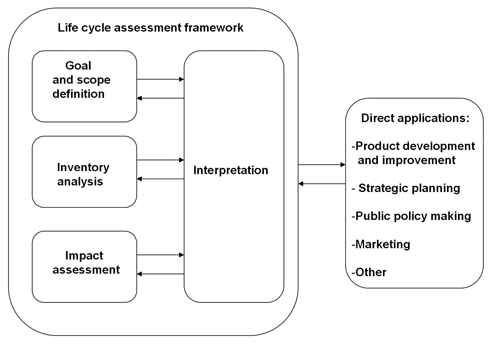MAIN PUBLICATION :
| Home � ENVIRONMENT � Environmental benefits � Concept of LCA |

|
The life cycle assessment (LCA) is an objective process to evaluate the environmental burdens associated with a product, process, or activity by identifying energy and materials used and wastes released to the environment and to evaluate and implement opportunities to affect environmental improvements (ISO, 1999).
The assessment includes the entire life cycle of the product, process or activity, encompassing extracting and processing raw materials; manufacturing, transportation and distribution; use, re-use and maintenance; recycling; and final disposal (the so called 'cradle to grave' concept).
According to the ISO 14040 and 14044 standards, a LCA is carried out in four phases:
- Goal and scope definition;
- Inventory analysis: compiling the relevant inputs and outputs of a product system;
- Impact assessment: evaluating the potential environmental impacts associated with those inputs and outputs; and
- Interpretation: the procedure to identify, qualify, check and evaluate the results of the inventory analysis and impact assessment phases in relation to the objectives of the study.

In the phase dealing with the goal and scope definition, the aim, the breadth and the depth of the study are established.
The inventory analysis (also called life-cycle inventory - LCI), is the phase of LCA involving the compilation and quantification of inputs and outputs for a given product system throughout its life cycle. LCI establishes demarcation between what is included in the product system and what is excluded. In LCI, each product, material or service should be followed until it has been translated into elementary flows (emissions, natural resource extractions, land use and so on).
The third phase, life-cycle impact assessment, aims to understand and evaluate the magnitude and significance of the potential environmental impacts of a product system. This phase is further divided into four steps. The first two steps are termed classification and characterisation, and impact potentials are calculated based on the LCI results. The next steps are normalisation and weighting, but these are both voluntary according to the ISO standard. Normalisation provides a basis for comparing different types of environmental impact categories (all impacts get the same unit). Weighting implies assigning a weighting factor to each impact category depending on the relative importance.
The two first steps (classification and characterisation) are quantitative steps based on scientific knowledge of the relevant environmental processes, wheras normalisation and valuation are not technical, scientific or objective processes, but may be assisted by applying scientifically based analytical techniques.
| Acknowledgements | Sitemap | Partners | Disclaimer | Contact | ||
|
coordinated by  |
supported by  |
The sole responsibility for the content of this webpage lies with the authors. It does not necessarily reflect the opinion of the European Communities. The European Commission is not responsible for any use that maybe made of the information contained therein. |
